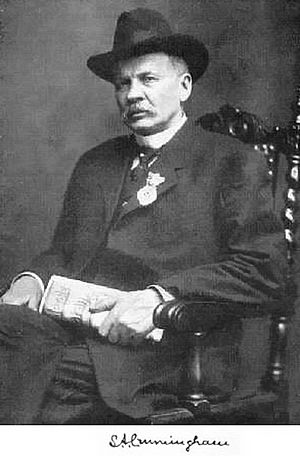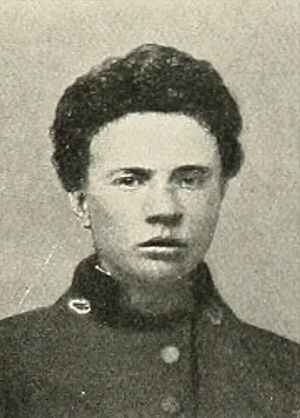Sumner Archibald Cunningham facts for kids
Quick facts for kids
Sumner Archibald Cunningham
|
|
|---|---|
 |
|
| Born | July 21, 1843 |
| Died | December 13, 1913 (aged 70) Nashville, Tennessee, U.S.
|
| Resting place | Willow Mount Cemetery, Shelbyville, Tennessee, U.S. |
| Occupation | Editor |
| Spouse(s) | Laura Davis |
| Children | 1 son, 1 daughter |
| Military career | |
| Allegiance | |
| Service/ |
|
| Years of service | 1861–1865 |
Sumner Archibald Cunningham (born July 21, 1843 – died December 13, 1913) was an American soldier and journalist. He served in the Confederate Army during the American Civil War. Later, he became known for starting and editing The Confederate Veteran magazine. This magazine was very popular among former Confederate soldiers.
Contents
Early Life and Military Service
Sumner Archibald Cunningham was born on July 21, 1843. His family lived in Bedford County, Tennessee. His parents were John Washington Campbell Cunningham and Mary A. Buchanan.
When the American Civil War began in 1861, Cunningham joined the Confederate States Army. He was first stationed at Camp Trousdale in Portland, Tennessee. During the war, he was captured by Union forces at the Battle of Fort Donelson. He became a prisoner at Camp Morton in Indianapolis.
After being released in a prisoner exchange, he returned to fighting. He took part in several important battles. These included the Battle of Chickamauga in September 1863. He also fought in the Battle of Missionary Ridge in November 1863. His last major battle was the Battle of Franklin in November 1864. He reached the rank of sergeant-major. He left the army after the Battle of Nashville in December 1864.
Career as a Journalist
After the war, Cunningham moved to Shelbyville, Tennessee. He worked as a merchant, selling dry goods. He also managed a bookstore in the town.
In 1871, he wrote a book called Reminiscences of the Forty-first Tennessee Infantry. That same year, he bought a local newspaper, The Shelbyville Commercial. He became its editor. He also edited the Rural Sun, a newspaper in Nashville, from 1874 to 1875.
By 1876, Cunningham bought The Chattanooga Times. This was a major newspaper in Chattanooga, Tennessee. He edited it for a while. In 1878, he leased the newspaper to Adolph Ochs, who later bought it. Cunningham also bought and edited The Cartersville Express in Cartersville, Georgia, in 1879.
In 1883, he started a new newspaper called Our Day. It was published in New York City and aimed at people from the Southern states. However, this newspaper did not last long and closed by 1885. From 1885 to 1892, he worked as a journalist for The Nashville American.
Founding The Confederate Veteran
Cunningham started his most famous project, The Confederate Veteran magazine, in 1893. It began in Nashville, Tennessee. At first, it was a newsletter to help raise money. The money was for building a monument to Jefferson Davis. Davis was the president of the Confederate States of America.
Over time, the magazine became very important. It was one of the most influential monthly magazines in the "New South." It made Cunningham a leader in the Lost Cause movement. This movement aimed to remember and honor the Confederate side of the Civil War.
Supporting Confederate Causes
Cunningham was very active in groups that honored Confederate veterans. He attended meetings of the executive committee of the United Confederate Veterans. For example, he was at a meeting in Louisville, Kentucky, in 1903.
He also played a role in the early days of the United Daughters of the Confederacy (UDC). This group was formed by women who wanted to honor Confederate soldiers. Cunningham encouraged the co-founders, Caroline Meriwether Goodlett and Anna Raines, to work together.
Cunningham helped dedicate several monuments. In September 1900, he attended the dedication of the Confederate Monument in Owensboro, Kentucky. On April 29, 1909, he was at the dedication of the Sam Davis Statue in Nashville. This statue was placed outside the Tennessee State Capitol. Cunningham had suggested that this statue be built.
Interestingly, in 1913, Cunningham helped build a sculpture of a Union veteran. This was Richard Owen, and the sculpture was placed at the Indiana Capitol in Indianapolis. People praised Cunningham for honoring a Union soldier. At the time of his death, he was also working on a monument for Dan Emmett. Emmett wrote the famous song "Dixie". Cunningham was also on the committee for the Jefferson Davis State Historic Site in Fairview, Kentucky. However, he passed away before it was finished.
A portrait of Cunningham was painted by the artist Cornelius Hankins.
Personal Life
Sumner Cunningham married Laura Davis on November 27, 1866. They had two children. Their son, Paul Davis Cunningham, worked as an engineer for the United States Army. He sadly drowned in the Rio Grande River while surveying the border. Their daughter died when she was a baby. Cunningham's wife, Laura, passed away in 1879.
Death and Legacy
Sumner Archibald Cunningham died on December 13, 1913. He passed away at Saint Thomas Hospital in Nashville, Tennessee. His funeral was held at the First Presbyterian Church in Nashville. He was buried at the Willow Mount Cemetery in Shelbyville, Tennessee.
After his death, many people honored Cunningham. In January 1914, the Nashville and Tennessee chapters of the United Daughters of the Confederacy passed resolutions in his honor. They also honored him at their yearly meeting in May 1914.
In 1915, there was a plan to build a museum in his honor. It would be a memorial museum for Confederate veterans. They tried to raise money for a fireproof building. However, the project did not get enough funds and was never built.
On October 28, 1921, a special monument was added to Cunningham's grave. It was made of bronze and granite by Italian sculptor Giuseppe Moretti. The Nashville chapter of the UDC also created a scholarship in his memory. It was called the S. A. Cunningham Scholarship at Peabody College (now part of Vanderbilt University).
Edith D. Pope took over as the editor of The Confederate Veteran after Cunningham's death. Cunningham's personal papers are kept at the Louis Round Wilson Special Collections Library. This library is located at the University of North Carolina at Chapel Hill.



